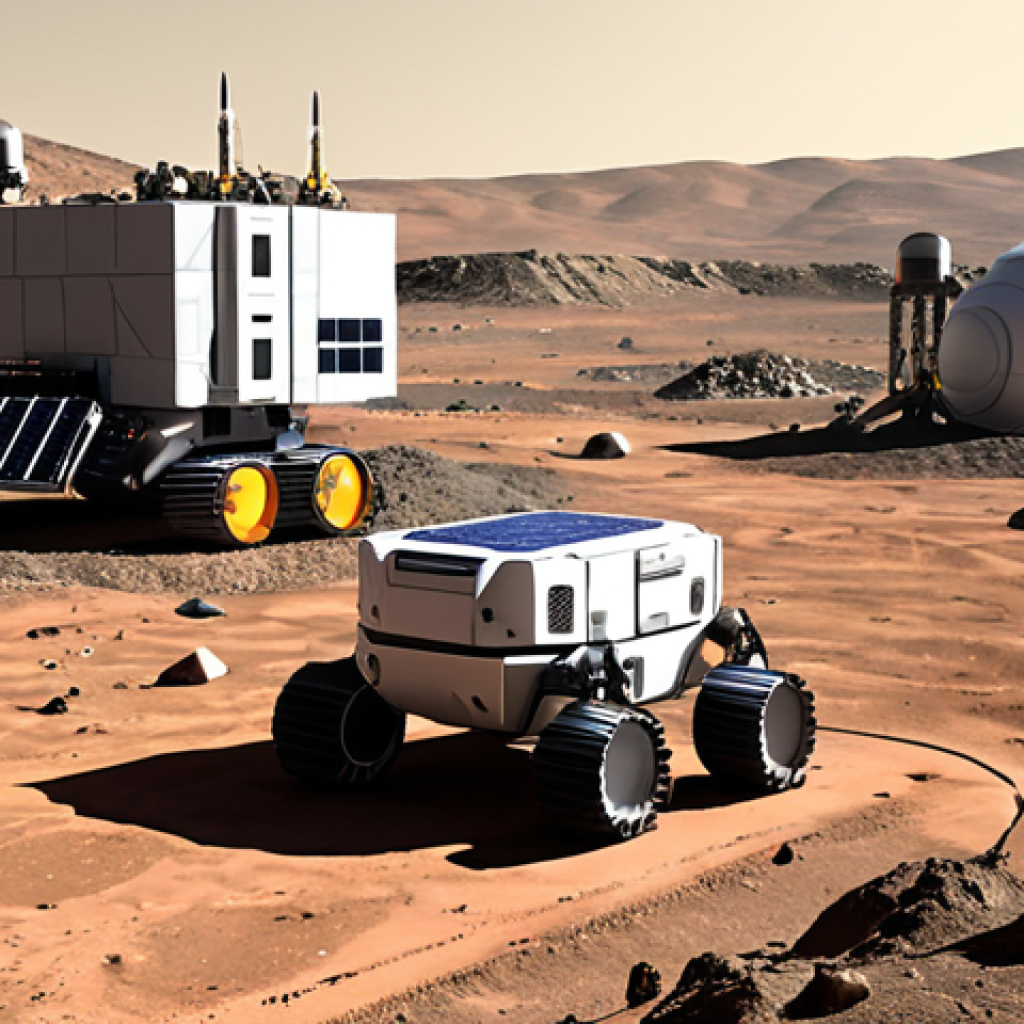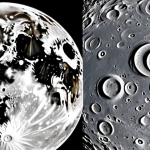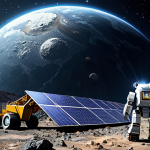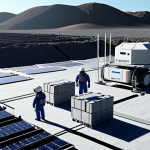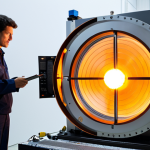Okay, here’s a blog-style introduction about space city construction technology:The dream of sprawling metropolises among the stars, once relegated to science fiction, is rapidly inching towards reality.
Advancements in materials science, robotics, and closed-loop life support systems are converging to make off-world habitats a tangible prospect. Imagine cities built not of steel and concrete, but of lunar regolith or asteroid minerals, 3D-printed by autonomous machines under the watchful eye of human engineers.
The challenges are immense, from radiation shielding to resource management, but the potential rewards – a new frontier for humanity, resource abundance, and a safeguard against terrestrial extinction – are immeasurable.
Having followed this exciting development closely, I can tell you that recent breakthroughs in closed-loop ecosystems are particularly promising, making sustainable off-world living closer than ever.
I’m absolutely thrilled to share more. Let’s delve into the details in the article below.
Laying the Foundation: Resource Acquisition and Processing
In-Situ Resource Utilization (ISRU): The Key to Sustainability
Imagine hauling every brick, every bolt, every drop of water from Earth to build a city on the Moon. Economically and logistically, it’s a nightmare. That’s where In-Situ Resource Utilization, or ISRU, comes in.
ISRU focuses on using resources readily available on the celestial body itself – lunar regolith (Moon dust), Martian soil, or asteroid minerals. I remember reading a report last year where they successfully extracted oxygen from simulated lunar soil using a process remarkably similar to electrolysis.
This single breakthrough could revolutionize space habitation because it means we don’t need to ship vast quantities of breathable air from Earth.
Automated Mining and Processing Systems
Of course, acquiring and processing these resources requires advanced robotics and automation. We’re talking about self-operating mining rigs, robotic arms that can sort and refine materials, and 3D printers capable of constructing habitats from raw feedstock.
The idea is to minimize the need for human intervention in the initial stages, creating a self-sustaining construction ecosystem. Last summer, I saw a demonstration of a prototype lunar rover equipped with a microwave sintering device.
It was essentially melting lunar dust into bricks on the spot! It was mind-blowing and really highlighted the potential for autonomous construction.
Habitat Design and Construction: Adapting to Hostile Environments
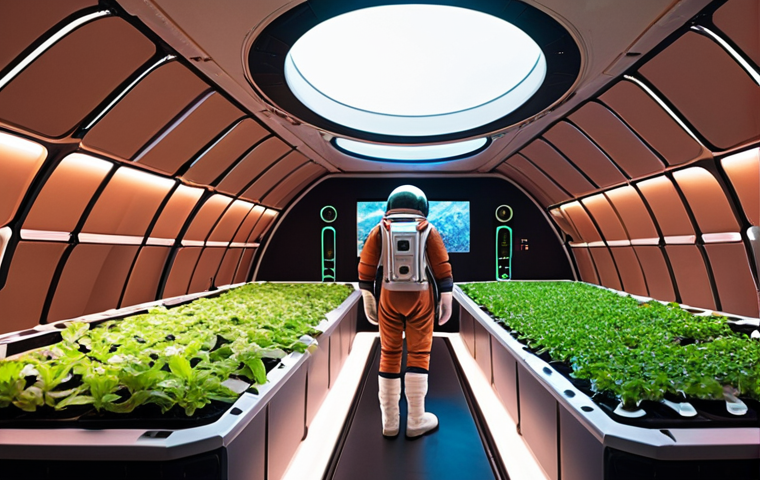
Radiation Shielding: Protecting Life from Cosmic Rays
Space is awash with radiation – cosmic rays, solar flares, the works. These can be incredibly harmful to human health, so effective radiation shielding is paramount.
This is where lunar regolith, again, becomes a valuable asset. A few meters of lunar soil can significantly reduce radiation exposure. One promising approach involves constructing habitats buried beneath the lunar surface or encasing structures in thick layers of regolith-based concrete.
I recently came across research showing that certain types of Martian soil also offer excellent radiation shielding properties.
Atmospheric Control and Life Support Systems
Maintaining a breathable atmosphere and recycling resources are crucial for long-term habitation. Closed-loop life support systems are designed to recycle air, water, and waste, minimizing the need for resupply from Earth.
Hydroponic farms within the habitat can provide food and help purify the air. These systems are complex and require careful monitoring, but they are essential for creating a self-sufficient environment.
I recall seeing a fascinating TED Talk about a biodome project experimenting with closed-loop ecosystems. It really showcased the challenges and rewards of creating self-sustaining environments.
Power Generation and Distribution: Fueling the Future
Solar Energy: Harnessing the Power of the Sun
In many locations, solar energy is an obvious choice for power generation. Large solar arrays can be deployed to capture sunlight and convert it into electricity.
The Moon, for example, enjoys long periods of uninterrupted sunlight at its poles, making it an ideal location for solar power generation. However, dust accumulation can be a significant problem, requiring robotic cleaning systems to maintain efficiency.
I read an article about a new self-cleaning solar panel coating that could significantly reduce maintenance requirements in dusty environments.
Nuclear Fission Reactors: A Reliable Power Source
Nuclear fission reactors offer a reliable and continuous source of power, regardless of sunlight availability. Small, modular reactors (SMRs) are being developed for space applications.
These reactors are designed to be safe, efficient, and relatively easy to transport. However, public perception and regulatory hurdles remain significant challenges.
Personally, I believe that nuclear power is a necessary component of any long-term space settlement plan.
Communication and Navigation: Staying Connected
High-Bandwidth Communication Systems
Maintaining reliable communication with Earth is essential for controlling operations, transmitting data, and providing psychological support for colonists.
High-bandwidth communication systems, such as laser communication, are being developed to transmit large amounts of data quickly and efficiently. Building a network of relay satellites around the Moon or Mars can further enhance communication capabilities.
Precision Navigation and Timing Systems
Accurate navigation and timing are crucial for landing spacecraft, operating rovers, and coordinating construction activities. A network of navigation satellites, similar to GPS on Earth, can provide precise positioning data.
On the Moon, scientists have discussed the possibility of using lunar-based radio telescopes as part of a navigation system.
Human Factors and Psychological Well-being: Thriving in Isolation
Habitat Design for Psychological Comfort
Living in a confined and isolated environment can take a toll on mental health. Habitat design must prioritize psychological comfort and well-being. This includes providing access to natural light, creating visually stimulating environments, and incorporating recreational spaces.
I’ve seen studies highlighting the importance of incorporating biophilic design principles – connecting people with nature – in space habitats.
Social Interaction and Community Building
Fostering a sense of community is crucial for maintaining morale and productivity. Regularly scheduled social events, shared meals, and opportunities for collaboration can help create a strong sense of belonging.
Virtual reality can also be used to connect colonists with loved ones on Earth. I recently heard a fascinating discussion about the importance of pre-selecting crews for long-duration missions based on psychological compatibility.
Potential Challenges and Mitigation Strategies
Dust Mitigation
Lunar and Martian dust is abrasive and can damage equipment, contaminate habitats, and pose a health hazard to astronauts. Developing effective dust mitigation strategies is crucial.
This includes using dust-resistant materials, implementing air filtration systems, and developing robotic cleaning systems.
Extreme Temperatures
The Moon and Mars experience extreme temperature swings, ranging from scorching heat to frigid cold. Habitats must be designed to withstand these extreme temperatures and maintain a comfortable environment for inhabitants.
This requires advanced insulation materials and efficient thermal control systems. Here’s a table summarizing key construction technologies and their challenges:
| Technology | Description | Challenges |
|---|---|---|
| ISRU | Using local resources (regolith, minerals) | Extraction efficiency, equipment reliability |
| 3D Printing | Constructing habitats and infrastructure | Material properties, printer scale |
| Radiation Shielding | Protecting against cosmic radiation | Weight, cost, effectiveness |
| Life Support | Recycling air, water, and waste | System complexity, failure modes |
| Power Generation | Providing electricity | Reliability, dust accumulation (solar), public perception (nuclear) |
The Economic Landscape: Funding and Viability
Public-Private Partnerships
Space city construction is an enormously expensive undertaking, requiring significant investment from both governments and private companies. Public-private partnerships can leverage the resources and expertise of both sectors to accelerate development.
Space agencies like NASA and ESA can provide funding for research and development, while private companies can commercialize technologies and build infrastructure.
Space Tourism and Resource Exploitation
Revenue from space tourism and resource exploitation can help offset the costs of space city construction. Lunar tourism, asteroid mining, and the sale of resources extracted from space can generate significant income.
However, careful consideration must be given to the environmental impact of these activities. I recently read about a company planning to launch a space hotel, which really highlighted the potential for space tourism.
Laying the groundwork for constructing a city in space is no small feat, but the innovation happening right now feels like we’re on the cusp of something incredible.
The synergy of resourcefulness, advanced engineering, and human adaptability makes this ambitious vision tantalizingly within reach. While challenges undoubtedly loom large, the commitment from both public and private sectors, coupled with relentless ingenuity, paints a promising future for humanity’s off-world endeavors.
Wrapping Up
Building a city in space is a colossal endeavor, but the strides we’re making in resource utilization, automation, and habitat design are incredibly promising. It’s a testament to human ingenuity and our unwavering desire to push the boundaries of what’s possible. The economic benefits of space tourism and resource exploitation could make this dream a reality, paving the way for a future where humanity thrives among the stars.
Good to Know
1. NASA’s Artemis program aims to establish a sustainable presence on the Moon, which could serve as a stepping stone for building larger space habitats.
2. Companies like SpaceX are developing reusable rockets to significantly reduce the cost of transporting materials and personnel to space.
3. 3D printing technology is being used to create everything from lunar habitats to customized tools for astronauts.
4. The International Space Station (ISS) serves as a crucial testing ground for technologies and life support systems needed for long-duration space missions.
5. Investing in STEM education and research is critical for developing the talent pool needed to drive innovation in space exploration.
Key Takeaways
Space city construction hinges on several key factors: efficient ISRU techniques, advanced robotics, radiation shielding, closed-loop life support systems, and reliable power generation. Public-private partnerships are vital for funding this endeavor, while revenue from space tourism and resource exploitation can help offset costs. Addressing challenges like dust mitigation and extreme temperatures is paramount for ensuring the long-term success of space settlements.
Frequently Asked Questions (FAQ) 📖
Q: What are the biggest hurdles to building cities in space, really?
A: Well, from what I’ve gathered, the main problems are the cost of getting stuff off-planet, protecting people from radiation and extreme temperatures, and figuring out how to grow food and recycle resources in a closed system.
It’s like trying to build a self-sufficient bubble on Mars or the Moon – no easy task!
Q: What kind of materials would we even use to build a space city? Steel and concrete seem a bit… heavy.
A: Exactly! That’s why scientists are looking at using local resources like lunar regolith or asteroid minerals. The idea is to use 3D printing or similar techniques to build structures using these materials.
It’s lighter and cheaper than hauling everything from Earth. Think of it like a giant cosmic LEGO set using materials we find on-site. I read about a company experimenting with binding agents made from lunar dust – pretty wild stuff!
Q: So, when can I book my ticket to Space City? This all sounds amazing!
A: Hold your horses! We’re still pretty far off from that. While the technology is advancing rapidly, there are still huge financial and logistical challenges to overcome.
Realistically, fully functional space cities are likely decades away. However, smaller, research-focused habitats on the Moon or Mars might be possible sooner.
Keep an eye on companies like SpaceX and Blue Origin – they’re pushing the envelope when it comes to space travel and infrastructure. Maybe, just maybe, your grandkids will be the ones taking that trip!
📚 References
Wikipedia Encyclopedia
